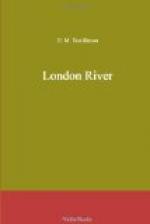For though Londoners understand the Guildhall pigeons have as much right to the place as the aldermen, they look upon the seabirds by London Bridge as vagrant strangers. They do not know where their city ends on the east side. Their River descends from Oxford in more than one sense. It has little history worth mentioning below Westminster. To the poets, the River becomes flat and songless where at Richmond the sea’s remote influence just moves it; and there they leave it. The Thames goes down then to a wide grey vacuity, a featureless monotony where men but toil, where life becomes silent in effort, and goes out through fogs to nowhere in particular. But there is a hill-top at Woolwich from which, better than from Richmond, our River, the burden-bearer, the road which joins us to New York and Sydney, can be seen for what it is, plainly related to a vaster world, with the ships upon its bright path moving through the smoke and buildings of the City. And surely some surmise of what our River is comes to a few of that multitude who cross London Bridge every day? They favour the east side of it, I have noticed, and they cannot always resist a pause to stare overside to the Pool. Why do they? Ships are there, it is true, but only insignificant traders, diminished by sombre cliffs up which their cargo is hauled piece-meal to vanish instantly into mid-air caverns; London absorbs all they have as morsels. Anyhow, it is the business of ships. The people on the bridge watch another life below, with its strange cries and mysterious movements. A leisurely wisp of steam rises from a steamer’s funnel. She is alive and breathing,




